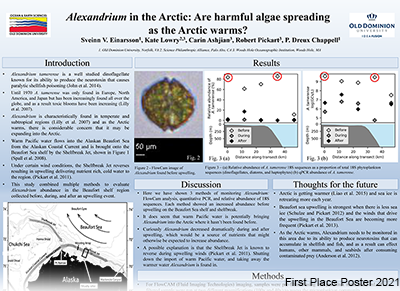College
College of Sciences
Department
Ocean/Earth/Atmos Sciences
Program
Oceanography
Publication Date
4-2021
DOI
10.25883/cj52-mm43
Abstract
Alexandrium tamerense is a well-studied dinoflagellate known for its ability to produce the neurotoxin that causes paralytic shellfish poisoning. Until 1970 Alexandrium tamerense was only found in Europe, North America, and Japan but has been increasingly found all over the globe. Alexandrium is characteristically found in temperate and subtropical regions and as the Arctic warms, there is considerable concern that it may be expanding into the Arctic. We found Alexandrium tamerense during a research expedition to the Alaskan Beaufort Sea shelf to study upwelling. Upwelling events are known to support seasonal blooms of phytoplankton, which are important primary producers at the base of the oceanic food web. The Beaufort Sea in the Arctic Ocean is known to experience upwelling due to storms caused by atmospheric pressure differences between air masses over Canada and Alaska. This upwelling is becoming more frequent as sea ice melts and the Arctic becomes warmer. We examined the upwelling system in the Beaufort Sea during one of these storms, by collecting surface water samples before, during, and after an upwelling event. Here we present observations of Alexandrium tamarense, found before upwelling occurred, using three different methods.
Keywords
Phytoplankton, Algae, Harmful algal blooms, Arctic
Disciplines
Biogeochemistry | Marine Biology | Oceanography
Files
Download Full Text (769 KB)
Recommended Citation
Einarsson, Sveinn; Lowry, Kate; Pickart, Robert; Ashjian, Karin; and Chappell, P. Dreux, "Alexandrium in the Arctic: Are Harmful Algae Spreading as the Arctic Warms?" (2021). College of Sciences Posters. 13.
https://digitalcommons.odu.edu/gradposters2021_sciences/13



